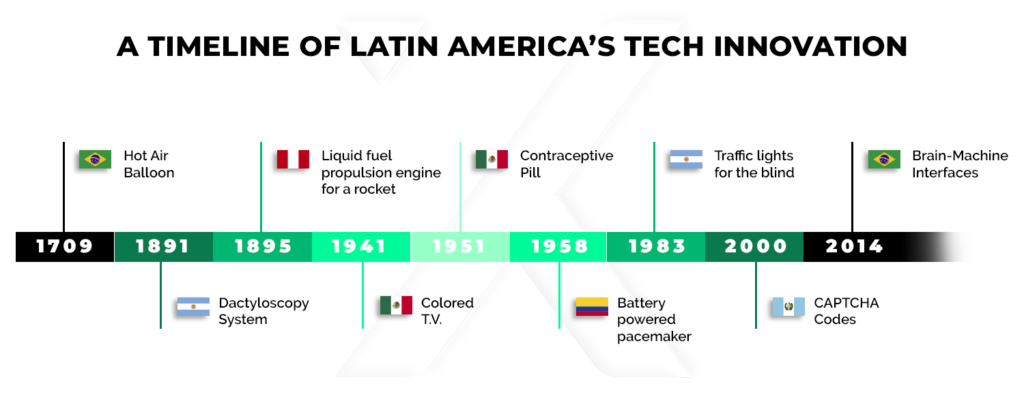Contxto – Perhaps it’s not something you hear every day, but, Latin America is home to some of the greatest inventors and innovators of all time. What’s more, the minds behind game-changing tech solutions like the liquid-fueled rocket engine and color television were born in the region.
As you know, at Contxto we work hard every day to communicate all the great things that are happening in Latin America related to tech, startups and innovation. Which is why it’s such a treat to present some of the most famous technological advancements from the region throughout history.
Furthermore, this is evidence that innovation is not foreign and new to the region, rather it has been occurring for quite some time. By the same token, the inventions and discoveries in this timeline have greatly contributed to the progress of humankind through their global application and use.

Brazil, 1709 Hot Air Balloon

Before airplanes came to steal all the high-flying glory, hot air balloons were, in fact, the first medium used by humans to become airborne. In short, the first successful flight humans ever experienced was through one of these rigs.
Early experimentation towards this invention is found in early XVIII century Brazil. The mind behind initial tests was Brazilian priest and inventor, Bartolomeu Lorenço de Gusmão.
In the beginning, the balloons he handled consisted of a paper bag with hot air inside. Once the air in the bag became lighter than the air outside, the balloon propelled itself upwards with the basket attached to it. Bartolomeu was able to lift a balloon up to 4.5 meters.
Argentina, 1891 – Dactyloscopy System

The idea of identifying criminals by their fingerprints first came to the Argentine policeman, Juan Vucetich. Based on Francis Galton’s research, Vucetich developed his own method to compare fingerprints.
In 1891, Vucetich first collected samples from 23 prisoners for research purposes. However, it wasn’t until one year later, in 1892, when Vucetich’s method was really put to the test. Tasked with investigating the murder of two children in a town near Buenos Aires, our hero set out to find the culprit.
A man said to be a love interest to the victims’ mother was the first suspect. However, as soon as Vucetich compared the prints of the crime scene to those of the people involved, he realized the prints matched the mothers’. What a plot twist! All thanks to a simple but innovative solution.
Peru, 1895 – Liquid fuel propulsion engine for rockets
No, the journey to the moon didn’t initiate during the Cold War with the US and the Soviet Union. Unbeknownst to most, it started in Arequipa, Peru with one young dreamer by the name of Pedro Paulet.
Curiously enough, this Peruvian drew his inspiration after he read Jules Verne’s novel “From the Earth to the Moon.” As a result, during his youth, he dedicated himself to his studies and even designed his own spacecraft.
Eventually, his efforts led him to Europe. Back then, the scientific community focused on developing gunpowder-based rocket engines. Meanwhile, in Paris, Paulet had built the first liquid-fueled rocket engine.
Sadly to say that, aside from the Nazis, nobody showed any interest in his work. However, Paulet refused to work with them. For his revolutionary insight, Paulet is considered by some as the father of astronautics.
Mexico, 1941 – Color television

Like Paulet, Guillermo González Camarena from Mexico showed an interest in science at a young age. Moreover, this inventor in the making began building electronic devices when he was 7 years old.
In 1939 Camarena created the first system that transformed television signals into color. His invention, the Trichromatic Sequential Fields system, became patented in Mexico in 1940, then in the United States in 1941.
Not long after, audiences everywhere would be able to enjoy colored television from the comfort of their homes.
Mexico, 1951 – Contraceptive pill

As an undergrad in chemistry with promising potential, a pharmaceutical company hired Mexican-born Luis Miramontes. Together with Carl Djerassi and George Rosenkrantz, Miramontes began developing synthetic progesterone. The purpose of this endeavor was to create a new contraceptive method.
On October 15, 1951, Miramontes synthesized an anti-ovulatory compound named norethisterone for the first time. This led to the commercialization of “Norinyl,” a contraceptive containing the synthesized compound. Although we commonly refer to this solution as “the pill,” or simply birth control.
Ultimately, Miramontes joined the ranks of the U.S. Inventor’s Hall of Fame in 1964. He is the only Mexican scientist to have achieved such a feat.
Argentina, 1983 – Traffic lights for the blind

Blindness brings about many challenges. Wanting to at least simplify the process of crossing the street, Argentine inventor Mario Dávila patented a special traffic light for the visually impaired in 1983.
His device was simple to understand and use. An electronic panel was set on the post of a traffic signal located at an intersection. When the green light was on, and cars sped by, the panel made a slow-paced, intermittent sound. This warned users they couldn’t cross.
When the red light came on and pedestrians could safely cross, the panel emitted a loud and continuous sound. Of course, since then, these devices received a lot of innovation and new updates around the world.
Guatemala, 2000 – CAPTCHA Codes

Yes, we know nobody enjoys CAPTCHA codes. However, Guatemalan Luis Von Ahn had users in mind when he developed this solution at the dawn of the XXI century.
Thanks to his “Completely Automated Public Turing test to tell Computers and Humans Apart,” or “CAPTCHA” for short, offered an additional layer of protection to keep malicious programs and bots from accessing sensitive information by creating a test that only humans can solve.
Over time, CAPTCHA codes have been getting harder since computers keep getting smarter. Years later, in 2009 Von Ahn sold ReCAPTCHA to Google for an undisclosed amount.
Fun fact: Luis Von Ahn is the founder of Duolingo, one of the best apps for learning new languages.
Brazil, 2014 – Brain-Machine Interfaces
During Brazil’s 2014 World Cup, a paraplegic in a robotic suit performed the “symbolic kick-off” to inaugurate the games. Needless to say, everybody was impressed. Behind this grand presentation was a group of scientists led by Brazilian Miguel Nicolelis.
Alongside Nicolelis is a team of 150 scientists still working to create and perfect a suit to assist people with motor disabilities. This exoskeleton converts electric signals from the brain into movements performed by the suit. To achieve this, electrodes are placed on a large area of the brain to capture neural signals.
-CZ





